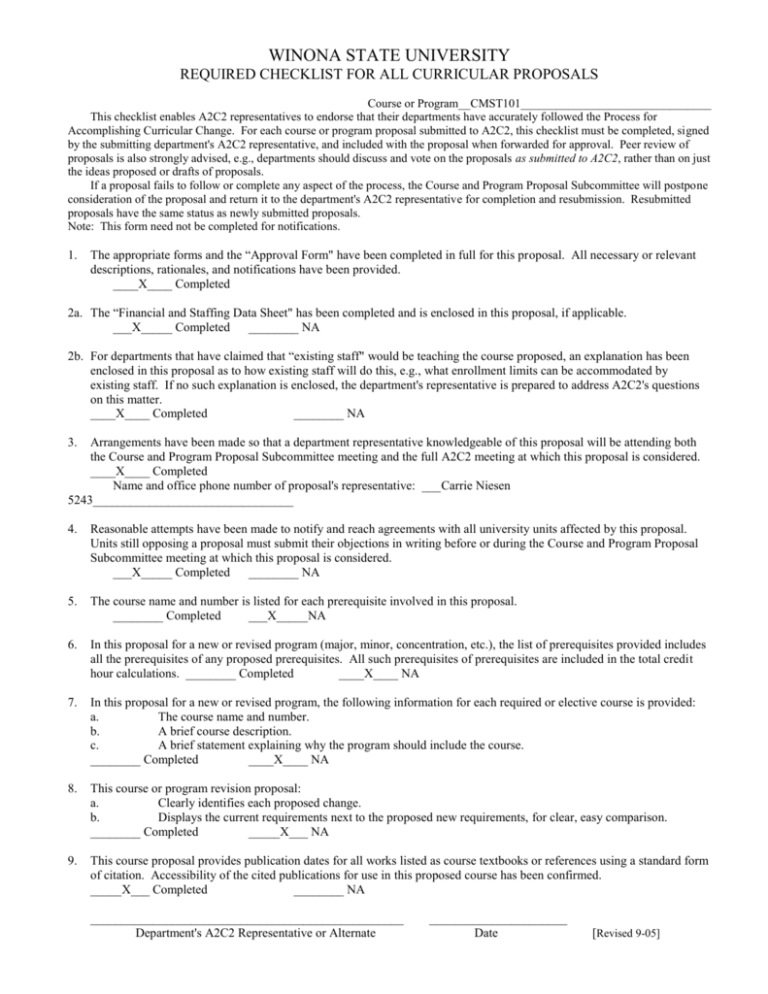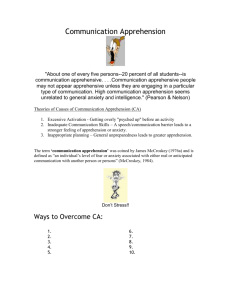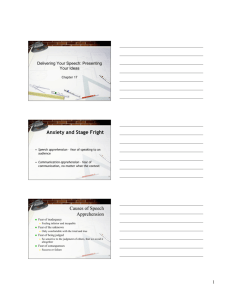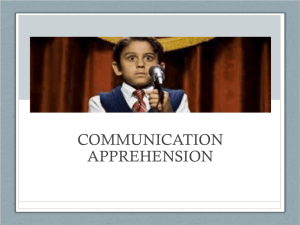CMST 101 CPPS - Winona State University
advertisement

WINONA STATE UNIVERSITY REQUIRED CHECKLIST FOR ALL CURRICULAR PROPOSALS Course or Program__CMST101________________________________ This checklist enables A2C2 representatives to endorse that their departments have accurately followed the Process for Accomplishing Curricular Change. For each course or program proposal submitted to A2C2, this checklist must be completed, signed by the submitting department's A2C2 representative, and included with the proposal when forwarded for approval. Peer review of proposals is also strongly advised, e.g., departments should discuss and vote on the proposals as submitted to A2C2, rather than on just the ideas proposed or drafts of proposals. If a proposal fails to follow or complete any aspect of the process, the Course and Program Proposal Subcommittee will postpone consideration of the proposal and return it to the department's A2C2 representative for completion and resubmission. Resubmitted proposals have the same status as newly submitted proposals. Note: This form need not be completed for notifications. 1. The appropriate forms and the “Approval Form" have been completed in full for this proposal. All necessary or relevant descriptions, rationales, and notifications have been provided. ____X____ Completed 2a. The “Financial and Staffing Data Sheet" has been completed and is enclosed in this proposal, if applicable. ___X_____ Completed ________ NA 2b. For departments that have claimed that “existing staff" would be teaching the course proposed, an explanation has been enclosed in this proposal as to how existing staff will do this, e.g., what enrollment limits can be accommodated by existing staff. If no such explanation is enclosed, the department's representative is prepared to address A2C2's questions on this matter. ____X____ Completed ________ NA 3. Arrangements have been made so that a department representative knowledgeable of this proposal will be attending both the Course and Program Proposal Subcommittee meeting and the full A2C2 meeting at which this proposal is considered. ____X____ Completed Name and office phone number of proposal's representative: ___Carrie Niesen 5243________________________________ 4. Reasonable attempts have been made to notify and reach agreements with all university units affected by this proposal. Units still opposing a proposal must submit their objections in writing before or during the Course and Program Proposal Subcommittee meeting at which this proposal is considered. ___X_____ Completed ________ NA 5. The course name and number is listed for each prerequisite involved in this proposal. ________ Completed ___X_____NA 6. In this proposal for a new or revised program (major, minor, concentration, etc.), the list of prerequisites provided includes all the prerequisites of any proposed prerequisites. All such prerequisites of prerequisites are included in the total credit hour calculations. ________ Completed ____X____ NA 7. In this proposal for a new or revised program, the following information for each required or elective course is provided: a. The course name and number. b. A brief course description. c. A brief statement explaining why the program should include the course. ________ Completed ____X____ NA 8. This course or program revision proposal: a. Clearly identifies each proposed change. b. Displays the current requirements next to the proposed new requirements, for clear, easy comparison. ________ Completed _____X___ NA 9. This course proposal provides publication dates for all works listed as course textbooks or references using a standard form of citation. Accessibility of the cited publications for use in this proposed course has been confirmed. _____X___ Completed ________ NA __________________________________________________ Department's A2C2 Representative or Alternate ______________________ Date [Revised 9-05] WINONA STATE UNIVERSITY PROPOSAL FOR NEW COURSES Department __Communication Studies_______________________ Date __2/01/12_______________ Refer to Regulation 3-4, Policy for Changing the Curriculum, for complete information on submitting proposals for curricular changes. _CMST101_____________________ ___Speaking Confidently____________________________ Course No. Course Title This proposal is for a(n) Applies to: __X____ Undergraduate Course ______ Major _____ Required _____ Elective Prerequisites _____1________ Credits ______ Graduate Course ______ Minor _ ______ General Education Program* ______ University Studies Program* _____ Required _____ Elective ___None_____________________________________________________________________________________ Grading method ______ Grade only ______ P/NC only __X____ Grade and P/NC Option Frequency of offering ______One-time pilot (Fall 2012)_______________________ *For General Education Program course approval, the form Proposal for General Education Program Courses must also be completed and submitted separately according to the instructions on that form. For University Studies Program course approval, the form Proposal for University Studies Courses must also be completed and submitted separately according to the instructions on that form. Provide the following information: A. Course Description 1. Catalog description. This one-credit course is designed to prepare students with communication apprehension (CA) for speaking-intensive classes. It provides an overview of what CA is, and the contexts in which it occurs, and the short- and long-term effects it can have on speakers. Students will identify dimensions that trigger their own CA, and learn techniques to reduce anxiety about public speaking situations. 2. Course outline of the major topics and subtopics (minimum of two-level outline). I. II. Communication Apprehension and Speech Anxiety a. Definition of communication apprehension i. Types of communication apprehension (Trait-like; Generalized-content; Person-Group; Situational) ii. Assessment of Communication Apprehension b. Causes of speech anxiety i. Learned responses ii. Worrisome thoughts iii. Performance orientation iv. Perceived lack of public speaking skills v. Excessive activation vi. Situational aspects c. Effects of speech anxiety i. Short-term effects ii. Potential long-term effects Personality Dimensions Affected by Anxiety a. The BASICS personality dimensions of anxiety b. Tracking the firing order of the BASICS dimensions to get to the root of speaking anxiety and nervousness III. IV. Anxiety-reduction techniques a. Deep breathing b. Cognitive restructuring c. Systematic desensitization d. Mental rehearsal (visualization) e. Stress reduction plans f. Skills training Developing a multi-dimensional plan for conquering speech anxiety a. Matching personality dimensions to most appropriate anxiety-reduction techniques b. Setting and committing to goals for anxiety reduction c. Participating in public communication 3.a Instructional delivery methods utilized: (Please check all that apply). Lecture: Auditorium ITV Online Lecture: Classroom XXX Service Learning Travel Study Other: (Please indicate) 3.b. MnSCU Course media codes: (Please check all that apply). None: XXX 3. Internet 1. Satellite 4. ITV Sending 2. CD Rom 5. Broadcast TV Web Enhanced Laboratory 6. Independent Study 7. Taped 8. ITV Receiving Web Supplemented Internship/Practicum 9. Web Enhanced 10. Web Supplemented 4. Course requirements (papers, lab work, projects, etc.) and means of evaluation. Quizzes (4) Journal entries (5) Mini-speeches (3) In-class activities and personal assessments Personal action plan assignment See course outline in appendix for additional details. 5. Course materials (textbook(s), articles, etc.). Dwyer, K. (2005). Conquer your speech anxiety: Learn to overcome your nervousness about public speaking. Belmont, CA: Wadsworth. Dwyer, K. (2005). Conquering speech anxiety. [CD-ROM]. Belmont, CA: Wadsworth. 6. Assessment of Outcomes Main Topic Related Course Objective I. Communication Explain the meaning, contexts, causes, Apprehension and Speech occurrence, and the short- and (potential) Anxiety long-term (academic, social, career) effects of CA. (Objective 1) II. Personality dimensions affected by anxiety Describe the BASICS personality dimensions involved in CA. (Objective 2) Identify the firing order of the BASICS dimensions involved in personal CA. (Objective 3) III. Anxiety-reduction Techniques IV. Developing a multidimensional plan for conquering speech anxiety Assessment Measure Formative: Discussions, in-class activities and personal assessments Summative: Quizzes Formative: Discussions, in-class activities and personal assessments, journal entries Summative: Quizzes Explain and apply techniques for reducing CA, including: deep abdominal breathing, cognitive restructuring, systematic desensitization, mental rehearsal, stress reduction plans, and skills training. (Objective 4) Formative: Discussions, in-class activities, journal entries Explain and apply techniques for reducing CA, including: deep abdominal breathing, cognitive restructuring, systematic desensitization, mental rehearsal, stress reduction plans, and skills training. (Objective 4) Formative: In-class activities, journal entries, mini-speeches Summative: Quizzes and minispeeches Summative: Personal action plan assignment Design a personal action plan that includes appropriate techniques for reducing CA. (Objective 5) 7. List of references. Addison, P., Ayala, J., Hunter, M., Behnke, R. R., & Sawyer, C. R. (2004). Body sensations of higher and lower anxiety sensitive speakers anticipating a public presentation. Communication Research Reports, 21, 284-290. Ayres, J., & Hopf, T. S. (1993). Coping with speech anxiety. Norwood, NJ: Ablex Publishing Corporation. Behnke, R. R., Sawyer, C. R., & King, P. E. (1987). The communication of public speaking anxiety. Communication Education, 36, 138-141. Brodie, G.D. (2010). A racing heart, rattling knees, and ruminative thoughts: Defining, explaining, and treating public speaking anxiety. Communication Education, 59, 70-105. Dwyer, K. (2009). The multidimensional model for selecting interventions. In J.A. Daly, J.C. McCroskey, J. Ayers, T. Hopf, & D. Ayers (Eds.) Avoiding communication: Shyness, reticence, and communication apprehension (359-374). Cresskill, NJ: Hampton Press. Dwyer, K., Carlson, R.E., & Kahre, S. (2002). Communication apprehension and basic course success: The Labsupported public speaking course intervention. Basic Communication Course Annual, 14, 87-112. Dwyer, K., & Fus, D. (1999). Communication apprehension, self-efficacy, and grades in the basic course: Correlations and implications. Basic Communication Course Annual, 11, 108-132. Ellis, K. (1995). Apprehension, self-perceived competency, and teacher immediacy in the laboratory-supported public speaking course: Trends and relationships. Communication Education, 44, 64-78. Finn, A.N., Sawyer, C.R., & Behnke, R.R. (2009). A model of anxious arousal for public speaking. Communication Education, 58, 417-432. Finn, A. N., Sawyer, C. R., & Schrodt, P. (2009). Examining the effect of exposure therapy on public speaking state anxiety. Communication Education, 58, 92-109. Hopf, T.S., & J. Ayers. (1992). Coping with public speaking anxiety: An examination of various combinations of systematic desensitization, skills training and visualization. Journal of Applied Communication Research, 20, 183-198. McCroskey, J. C. (1970). Measures of communication-bound anxiety. Speech Monographs, 37, 269-277. McCroskey, J.C. (1982). Oral Communication apprehension: A reconceptualization. In M. Burgoon (Ed.), Communication Yearbook 6. Beverly Hills, CA: Sage. McCroskey, J.C., Booth-Butterfield, S., & Payne, S.K. (1989). The impact of communication apprehension on college student success and retention. Communication Quarterly, 37, 100-107. National Association of Colleges and Employers (2010). Job outlook: Verbal communication skills most sought by employers [data file]. Retrieved from: http://www.naceweb.org/so12082010/college_skills/ Richmond, V.P., & McCroskey, J.C. (1998). Communication apprehension, avoidance and effectiveness. (5th ed.). Boston, MA: Allyn and Bacon. Sawyer, C. R., & Behnke, R. R. (2002). Reduction in public speaking state anxiety during performance as a function of sensitization processes. Communication Quarterly, 50, 110-121. Smith, C. D., Sawyer, C. R., & Behnke, R. R. (2005). Physical symptoms of discomfort associated with worry about giving a public speech. Communication Reports, 18, 31-41. Smith, T. E., & Frymier, A. B. (2006). Get ‘real’: Does practicing speeches before an audience improve performance? Communication Quarterly, 54, 111-125. Witt, P., & Behnke, R.R. (2006). Anticipatory speech anxiety as a function of public speaking assignment type. Communication Education, 55, 167-177. Wrench, J.S., Brogan, S.M., McCroskey, J.C., & Jowi, D. (2008). Social communication apprehension: The intersection of communication apprehension and social phobia. Human Communication, 11, 409-430. B. Rationale 1. Statement of the major focus and objectives of the course. The major focus of this course is to understand the sources of communication apprehension (CA) and help students identify and apply appropriate interventions for reducing their anxiety about public speaking. Specifically, after taking this class, students will be able to: Explain the meaning, contexts, causes, occurrence, and potential long-term (academic, social, career) effects of CA. Describe the BASICS personality dimensions involved in CA. Identify the firing order of the BASICS dimensions involved in their own CA. Explain and apply techniques for reducing CA, including: deep abdominal breathing, cognitive restructuring, systematic desensitization, mental rehearsal, stress reduction plans, and skills training. Design a personal action plan that includes appropriate techniques for reducing CA. 2. Specify how this new course contributes to the departmental curriculum. Communication apprehension, or the fear or anxiety associated with real or anticipated communication, is considered the most widely studied concept in the communication studies discipline (Brodie, 2010; McCroskey, 1982; Wrench, Brogan, McCroskey, & Jowi, 2008). Although research indicates that nearly all speakers experience some from of CA, an estimated 15-20 percent of the general population experience high or severe levels of CA that cause them to avoid or withdraw from communication situations (see McCroskey; Richmond & McCroskey, 1998). Despite the prevalence of CA, oral communication skills are essential in the classroom and the workplace. Winona State University students are required to take CMST 191 (Introduction to Public Speaking) to fulfill the Oral Communication component of the University Studies Basic Skills Curriculum. Additionally, oral communication is ranked among the top skills that employers seek in new college graduates (National Association of Colleges and Employers, 2010). During any given semester at WSU, an estimated 1,000 students enroll in CMST 191. Extrapolating from the existing research, an estimated 200 students in the public speaking course experience high levels of CA. Institutional data further indicates that on a yearly basis, approximately 300 students do not take CMST 191 during their first year of enrollment. This trend raises multiple concerns for student retention and progress towards matriculation: First, disciplinary research indicates that students with high CA are more likely to drop out than students with low CA, particularly during the first two years of enrollment (see, for example, McCroskey, Booth-Butterfield, & Payne, 1989). Second, the institutional data suggests that students are postponing or avoiding enrollment in CMST 191, which could delay their ability to take other courses or their entrance to a major. Third, when students who have delayed taking CMST 191 do enroll in the course, the classes fill up earlier in the registration period –leaving fewer seats available for new students. The pilot run of this course in Fall 2012 is intended to address these concerns by providing students with high CA with knowledge and techniques that can help them reduce public speaking anxiety. We have consulted with several campus partners about piloting this course (specifically, Advising and Tutoring Services, Counseling Services, Disability Services, and Student Support Services). They support our efforts as part of a broader plan to address the needs of students with high communication apprehension. 3. C. Indicate any course(s) which may be dropped if this course is approved. None. Impact of this Course on other Departments, Programs, Majors, or Minors 1. 2. Does this course increase or decrease the total credits required by a major or minor of any other department? If so, which department(s)? No. Attach letter(s) of understanding from impacted department(s). N/A Definitions: 01-Satellite: 02- CD Rom: 03- Internet: Predominately = where all, or nearly all, course activity occurs in an online environment. One to two activities may occur face-to-face in a classroom, with the maximum being two activities. 04 – ITV Sending: a course in which students are in the classroom with the instructor, other students join via interactive television technology from other geographically separate locations 05 – Broadcast TV: 06 – Independent Study: a course in which the teacher develops specialized curriculum for the student(s) based on department guidelines in the University course catalog 07 – Taped: a course in which the teacher records the lessons for playback at a later date 08 – ITV Receiving: a course in which students are not in the classroom with the teacher, other students join via interactive television technology from other geographically separate locations 09 – Web Enhanced- Limited Seat Time: For a course in which students are geographically separate from the teacher and other students for a majority of required activities. However, some on-site attendance is required. The course includes synchronous and/or asynchronous instruction. 10 – Web Supplemented- No Reduced Seat Time: For a course utilizing the web for instructional activities. Use of this code may assist your college/university in tracking courses for “smart classrooms” and/or facility usage. Attach a Financial and Staffing Data Sheet. Attach an Approval Form with appropriate signatures. Department Contact Person for this Proposal: ______________________________________________ Name (please print) ________________ Phone _______________________________ e-mail address [Revised 9-7-11] WINONA STATE UNIVERSITY FINANCIAL AND STAFFING DATA SHEET Course or Program:___CMST101_______________________________ Include a Financial and Staffing Data Sheet with any proposal for a new course, new program, or revised program. Please answer the following questions completely. Provide supporting data. 1. Would this course or program be taught with existing staff or with new or additional staff? If this course would be taught by adjunct faculty, include a rationale. The course will be taught by existing staff. 2. What impact would approval of this course/program have on current course offerings? Please discuss number of sections of current offerings, dropping of courses, etc. We will be offering the course as a one-time pilot in fall 2012. It will not affect existing course offerings. 3. What effect would approval of this course/program have on the department supplies? Include data to support expenditures for staffing, equipment, supplies, instructional resources, etc. None. [Revised 9-05] Appendix: Course Outline Communication Studies 101 Speaking Confidently Required Materials: Dwyer, K. (2005). Conquer your speech anxiety: Learn to overcome your nervousness about public speaking. Belmont, CA: Wadsworth. Dwyer, K. (2005). Conquering speech anxiety. [CD-ROM]. Belmont, CA: Wadsworth. Course Objectives: The major focus of this course is to help you prepare for other speaking-intensive classes. Together, we will examine the sources of communication apprehension (CA), and identify and apply appropriate techniques for reducing anxiety about public speaking. Specifically, after taking this class, you will be able to: Explain the meaning, contexts, causes, occurrence, and potential long-term (academic, social, career) effects of CA. Describe the BASICS personality dimensions involved in CA. Identify the firing order of the BASICS dimensions involved in their own CA. Explain and apply techniques for reducing CA, including: deep abdominal breathing, cognitive restructuring, systematic desensitization, mental rehearsal, stress reduction plans, and skills training. Design a personal action plan that includes appropriate techniques for reducing CA. Course Assignments and Grades: Quizzes Quizzes (4 @ 25 pts each) Points Possible/Points Earned 100 /_____ Speaking Assignments Mini-Speech 1 (Introduction) Mini-Speech 2 (Object) Mini-Speech 3 (Opinion) 20 20 20 /_____ /_____ /_____ Other Assignments Journal Reflection Assignments (5 @ 10 pts each) Personal Action Plan 50 40 /_____ /_____ TOTAL 250 /_____ Your final grade is a function of the number of points earned in the course divided by the total number of points, yielding a percentage. The following grading scale will be used in the course: A = 90%-100% B = 80%-89% C = 70%-79% D = 60%-69% F = 0%-59% Course Schedule Class Meeting Day 1 Day 2 Day 3 Activity Introduction to course Introduction to Communication Apprehension and Speech Anxiety Discuss the meaning, contexts, occurrence and possible effects of communication apprehension. Complete PRCA-24 assessment. Introduce the Deep Breathing Technique. Quiz 1: Covers chapters 1, 2, 6 Introduce the connections between negative thoughts and Assignments/Materials Needed Reading: Chapter 1 Due: Journal Entry 1 Reading: Chapters 2 & 6 Day 4 Day 5 Day 6 Day 7 Day 8 Day 9 Day 10 Day 11 Day 12 Day 13 feelings of fear, anxiety or nervousness. Explain steps in cognitive restructuring technique. Explain positive coping statements and assign students to develop their own coping statements master chart. Explain first mini-speech assignment. Students present mini-speeches Quiz 2: Covers chapters 3, 5 & 7 Explain BASICS & Tracking Firing Order. Discuss matching techniques to personality dimensions. Discuss Fight, Flight or Freeze Response. Introduce Systematic Desensitization. Continue discussing Systematic Desensitization. Continue practicing Systematic Desensitization. Quiz 3: Covers Chapters 4, 8 & 10 Discuss stress reduction plans, and the importance of physical exercise and interpersonal support. Discuss skills training. Discuss second mini-speech Students present mini-speeches. Explain Personal Action Plan assignment and final minispeech. Introduce mental rehearsal. Day 14 Quiz 4: Covers Chapters 9, 11 & 12 Continue discussing mental rehearsal Day 15 Discuss Personal Action Plans Complete PRCA-24 Assessment Students present final mini-speech Day 16 Reading: Chapters 3 & 7 Due: Journal Entry 2 Due: Mini-speech Outline Reading: Chapter 5 Reading: Chapters 4 & 8 Due: Journal Entry 3 Reading: Chapter 10 Reading: Chapter 11 Due: Journal Entry 4 Due: Mini-speech Outline Reading: Chapters 9 & 12 Due: Personal Action Plan assignment Due: Journal Entry 5 and Mini-Speech Outline WINONA STATE UNIVERSITY NEW AND REVISED COURSE AND PROGRAM APPROVAL FORM Routing form for new and revised courses and programs. Course or Program_____CMST101_____________________________ Department Recommendation _________________________________ Department Chair ________________ Date Dean’s Recommendation _____ Yes _________________________________ Dean of College ____________________________________________ e-mail address _____ No* ________________ Date *The dean shall forward their recommendation to the chair of the department, the chair of A2C2, and the Vice President for Academic Affairs. A2C2 Recommendation _____ Approved _____ Disapproved _________________________________ Chair of A2C2 ________________ Date Graduate Council Recommendation (if applicable) _____ Approved _________________________________ Chair of Graduate Council ________________ Date _________________________________ Director of Graduate Studies ________________ Date Faculty Senate Recommendation _____ Approved _________________________________ President of Faculty Senate _____ Disapproved _____ Disapproved ________________ Date Academic Vice President Recommendation _____ Approved ________________________________ Academic Vice President Decision of President _____ Approved _________________________________ President _____ Disapproved ________________ Date _____ Disapproved ________________ Date Please forward to Registrar. Registrar _________________ Date entered Please notify department chair via e-mail that curricular change has been recorded. [Revised 9-1-10]






